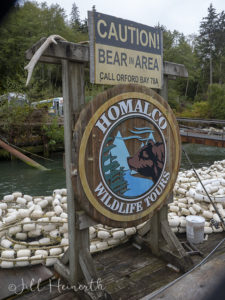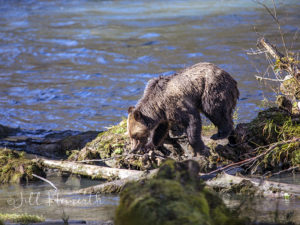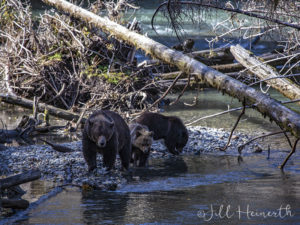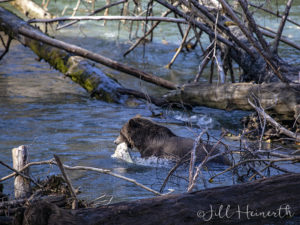 It is raining hard with a 35-knot wind pouring downslope from the coastal mountains into Bute Inlet. A fresh frosting of snow dusts the peaks with the season’s first freeze. We brace ourselves in the aluminum boat which is pounding over broken waves. Most other vessels have turned back today, unable to fight the combined forces of the wind and furious tidal currents that cycle in violent whirlpools and back eddies. But we are determined to reach the traditional territory of the Homlco Xwe’malhkwu Peoples in Bute Inlet. Like other Coastal First Nation peoples, the Homalco are stewards of the land that has provided them with fish, seafood, housing and hunting for generations. They are also guardians for an extraordinary population of grizzly bears that roam in the region that is the southern border of the Great Bear Rainforest. This primordial landscape offers an intact ecosystem where these great bears can flourish in lush valleys and rocky coastlines.
It is raining hard with a 35-knot wind pouring downslope from the coastal mountains into Bute Inlet. A fresh frosting of snow dusts the peaks with the season’s first freeze. We brace ourselves in the aluminum boat which is pounding over broken waves. Most other vessels have turned back today, unable to fight the combined forces of the wind and furious tidal currents that cycle in violent whirlpools and back eddies. But we are determined to reach the traditional territory of the Homlco Xwe’malhkwu Peoples in Bute Inlet. Like other Coastal First Nation peoples, the Homalco are stewards of the land that has provided them with fish, seafood, housing and hunting for generations. They are also guardians for an extraordinary population of grizzly bears that roam in the region that is the southern border of the Great Bear Rainforest. This primordial landscape offers an intact ecosystem where these great bears can flourish in lush valleys and rocky coastlines.
 At the dock, Conrad and James reach out to steady us as we step out of the boat, our wobbly legs adjusting to the solid ground. They offer a safety briefing below a sign that warns, “Caution! Bear in Area!” reminding us that the numerous animals we will see are aggressive predators. We must remain close to our guides. But the big bears of the Orford River are currently preoccupied, gorging on salmon that has returned to the area to spawn in the glacial meltwater. It is mere moments from climbing into a viewing stand that I see my first bears, wandering from the Douglas Firs and lofty Western Cedars, to the water’s edge, nose down and looking for a catch. A healthy male of perhaps 250 kilos ambles heavily along a fallen log. He slips and briefly straddles the log, then rights himself again. Pausing, he reaches down into the water, hooking a salmon with the first swipe. The bear drags the quivering meter-long fish to a pebbled beach to pull apart the meat. It is devoured in minutes, and he begins the cycle again.
At the dock, Conrad and James reach out to steady us as we step out of the boat, our wobbly legs adjusting to the solid ground. They offer a safety briefing below a sign that warns, “Caution! Bear in Area!” reminding us that the numerous animals we will see are aggressive predators. We must remain close to our guides. But the big bears of the Orford River are currently preoccupied, gorging on salmon that has returned to the area to spawn in the glacial meltwater. It is mere moments from climbing into a viewing stand that I see my first bears, wandering from the Douglas Firs and lofty Western Cedars, to the water’s edge, nose down and looking for a catch. A healthy male of perhaps 250 kilos ambles heavily along a fallen log. He slips and briefly straddles the log, then rights himself again. Pausing, he reaches down into the water, hooking a salmon with the first swipe. The bear drags the quivering meter-long fish to a pebbled beach to pull apart the meat. It is devoured in minutes, and he begins the cycle again.
The bears of Bute Inlet will spend nearly three months feasting on the rich, fatty meat of Chum and Coho Salmon that live and spawn in the area. The species Ursus arctos, is the most widely distributed bear species, ranging through Asia, Europe, China, Japan, Alaska and as far south as California and yet their populations are in sharp decline. Pressures from habitat loss, climate change, and hunting threaten their survival.
 We see a mother bear with two cubs proceed in our direction. Grizzly moms will start to breed between five and seven years of age and will continue through their 25-year lifespan. The playful cubs will stay with their mother for up to three years when she will bear one to three more. The two youngsters are more interested in eating than hunting. The mother stalks through the branches of a fallen tree to find salmon hiding in the shadows of the shallow river.
We see a mother bear with two cubs proceed in our direction. Grizzly moms will start to breed between five and seven years of age and will continue through their 25-year lifespan. The playful cubs will stay with their mother for up to three years when she will bear one to three more. The two youngsters are more interested in eating than hunting. The mother stalks through the branches of a fallen tree to find salmon hiding in the shadows of the shallow river.
Meanwhile, the two cubs are laying on the beach and pulling apart fish heads without paying much attention to her work effort. She crosses the fast water to the other bank, and suddenly the Cubs feel vulnerable. They launch into the water but are not strong enough to fight the current and are quickly swept downstream where a large male bear appears on the bank. Alerted to their cry, the mother drops her hunted and chases the interloping bear out of the area, ensuring that her youngsters are safely ashore. Within minutes she has another fish to offer them.
 As we snap photographs, our guides share the history of their ancestors, revealing that missionaries of the late 1860’s tried to erase their culture by forcing them to burn all their regalia, carvings and masks. The Homalco People were banned from holding ceremonies, speaking their indigenous language and were moved off their traditional land. Within forty years, most children were forced into residential schools where every attempt was made to break up the family and cultural ties. Their community still struggles today as they try to deal with the difficulties of reassembling their culture, but they have vowed to protect the environment, this community of bears and salmon and ensure that they live on protected in their natural habitat.
As we snap photographs, our guides share the history of their ancestors, revealing that missionaries of the late 1860’s tried to erase their culture by forcing them to burn all their regalia, carvings and masks. The Homalco People were banned from holding ceremonies, speaking their indigenous language and were moved off their traditional land. Within forty years, most children were forced into residential schools where every attempt was made to break up the family and cultural ties. Their community still struggles today as they try to deal with the difficulties of reassembling their culture, but they have vowed to protect the environment, this community of bears and salmon and ensure that they live on protected in their natural habitat.
